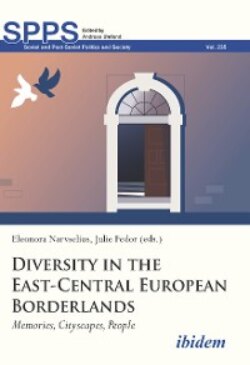Оглавление
Группа авторов. Diversity in the East-Central European Borderlands
List of Figures
Acknowledgments
Introduction. Remembering Diversity in East-Central European Cityscapes
Introduction1
Texture of Diversity in East-Central European Borderland Cities: Voids Filled and Voids Still Gaping
East-Central European Borderlands as a Cluster of Regional Distinctions, Banal Cosmopolitanism, and Urban Myths
Recollecting Bygone Urban Diversity: Performative Memories, Postmemory, and Prosthetic Memory
Engagements with Urban Diversity: Multicultural Heritage and Hybridity
REFERENCES
Urban Environment and Perished Populations in Chişinău, Chernivtsi, L’viv, and Wrocław. Historical Background and Memories Versus City Planning and Future Perspectives
Introduction
Chişinău–Kišinev (Kishinev) Interwar Chişinău in Historical Context
Chişinău During and Immediately After World War II
Chişinău/Kishinev in the Postwar Soviet Period
Chişinău in Post-Soviet Moldova
Chernivtsi–Cernăuţi–Czernowitz. Interwar Cernăuţi in Historical Context
Cernăuţi/Chernovtsy During and Shortly After World War II
Chernivtsi/Chernovtsy in the Postwar Soviet Period
Chernivtsi in Post-Soviet Ukraine
L’viv–Lwów–Lemberg. Interwar Lwów in Historical Context
Lwów/L’vov During and After World War II
L’viv/L’vov in the Postwar Soviet Period
L’viv in Post-Soviet Ukraine
Wrocław–Breslau. Interwar Breslau in Historical Context
Breslau/Wrocław During and Shortly After World War II
Wrocław in Postwar Polish Socialist Period
Wrocław in Post-Socialist Poland
Comparison between the Four Cities. Memories Reflected in the Built Structure and Urban Environment
Treatment of Memories in Urban Planning from Early Postwar Years until Today
Historical Values as City Branding
Concluding Remarks
REFERENCES
Between Anonymity and Attachment. Remembering Others in Lviv’s Pidzamche District
Introduction
Pidzamche: A Brief Introduction
Methodological Note
Remembering Others in Narratives about Pidzamche
Empty Houses in Lviv
Someone’s Space
Unique Objects
Helping and Empathy
Language and Communication
Holidays and Celebrations
Everyday Life and Cuisine
Conclusions: Into the Future of Pidzamche
REFERENCES
On the Peripheries of Memory. Tracing the History of the Old Jewish Cemetery in Wrocław’s Urban Imaginary
Introduction
Community (1856–1939)
Erasure I (1939–45)
Erasure II (1945–70)
Re-Emergence (1970–89)
Marginalization (1989–present)2
Conclusion
REFERENCES
Moving Forward through the Past. Bukovina’s Rediscovery after 1989–91
Introduction
“Europe’s Forgotten Region”: Bukovina’s Return to the Past
“Europe’s Forgotten Cemetery”: Bukovina’s Jewish Return
“Europe’s Shatterzone”: Bukovina’s Return from the Past
Conclusion
REFERENCES
Thinking Differently, Acting Separately? Heritage Discourse and Heritage Treatment in Chişinău
Introduction
Historical Background
Heritage Discourse: Interviewing the Cultural Elite
Theme 1: Heritage as a Shared Concern
Theme 2: Local History Timeline
Theme 3: The Collective “We” as “Elites”
Topic 4: Cityscape and Infrastructure
Heritage Treatment in Chişinău and Beyond
Jewish Chişinău between Abandonment and Reconstruction
Manuc Bey as a Tourist Attraction
A New Trend: Heritage Practice as Reconciliation
Conclusion
REFERENCES
Myths and Monuments in the Collective Consciousness and Social Practice of Wrocław
Monuments as a Device of Myths, History, and Memory: Theoretical Framework
Myths and Monuments in the Symbolic Landscape of Wrocław
In Lieu of Conclusion: Entanglements of History, Memory, and Mythical Thinking
REFERENCES
A Tragedy of the Galician DiversityCommemoration of Polish Professors Killed in Lviv during World War II
Introduction
Galician Diversity: A Balancing Act between Interaction and Zero-Sum Game
The Historical Context of the Murder on the Wuleckie Hills: Complicated Interactions, Tangled Stories
Execution of a Group of Polish Professors in Lviv: Riddles and Ambivalence surrounding a Wartime Murder
Commemoration of the Murdered Professors in Poland before 1989
Failed Attempts to Commemorate the Murder of the Professors in Soviet Lviv
“A monument with no inscription”: The Memorial to the Lviv Professors after the Fall of the Soviet System
REFERENCES
A Tangle of MemoryThe Eternitate Memorial Complex in Chişinău and History Politics in Moldova
Introduction
World War II and History Politics in Moldova
The Eternitate Memorial Complex: From Military Glory to National Commemoration
The Eternitate Complex as Site of Political Protest
The Memory of the Transnistrian Conflict at the Eternitate Complex: Heroic Continuity or Counter-Narrative?
Concluding Remarks
REFERENCES
Patterns of Collective Memory. Socio-Cultural Diversity in Wrocław Urban Memory
Introduction
Theoretical Approach
Methodological Note
Data Analysis: Temporal Dimension
The Meaning of the Past
Periodization: Linear versus Non-linear Time Structure
Non-Linear Time: Historical Analogies and Recurrent Mnemonic Clichés
Spatial Dimension
Discontinuation of Space (S1)
Continuation of Space (S2)18
Partial Continuation of Space (S3)
Perception and Meaning of Space
Conclusions
REFERENCES
Identificational and Attitudinal Trends in the Ukrainian–Romanian Borderland of Bukovina
Introduction
Borderlands and Belonging: A Brief Theoretical Account
Methodology
Historical Background
Data Analysis. Self-Identification, Belonging, and Attachment
Language
Perceptions of History and Culture
Conclusions
REFERENCES
About the Editors
About the Contributors
